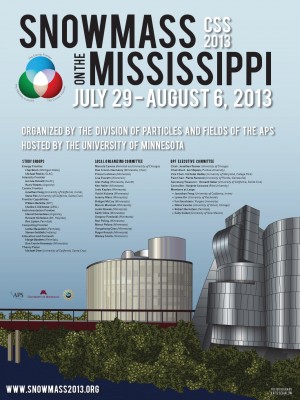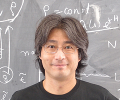The Snowmass meeting has just finished with a great deal of enthusiasm. I’m writing this article as I wait for my flight at Minneapolis-St. Paul airport under the lingering excitement from the meeting of more than 700 physicists. We discussed about the future of high-energy physics in the US and laid out scientific opportunities. There was a strong emphasis that we should think globally. I’m impressed by all the potential new projects addressing different aspects of particle physics, ranging from galaxy surveys and underground dark matter searches to high-energy colliders. And I believe the process built a broad consensus that the newly discovered Higgs boson must be studied with the best precision possible with a realistic plan, thanks to the tremendous amount of work done by many in the community.
The meeting is the finish line of a nine-month long marathon organised by the Division of Particles and Fields of the American Physical Society. The official title is “Community Summer Study 2013”, but out of tradition this type of meeting is called Snowmass because it used to be held as a three-week-long workshop in Snowmass, Colorado. This time the meeting had a new format with many pre-Snowmass meetings for energy, intensity and cosmic frontiers.
The study is not about setting priorities. There will be a committee called P5 (Particle Physics Projects Prioritization Panel) chaired by Steve Ritz, Director of Santa Cruz Institute for Particle Physics, University of California, Santa Cruz, that will come up with a realistic programme within certain budget scenarios from US Department of Energy (DOE) and National Science Foundation (NSF). Instead, the Snowmass meeting is meant to find and articulate scientific opportunities and our aspirations. All the plenary talks were truly impressive. I have learned a lot about what exciting discoveries may be waiting for us in the future. For instance, a Stage-IV cosmic microwave background experiment will not only reveal the structure of the Universe with B-mode polarisation from lensing, it can also measure the sum of neutrino masses down to the amazing accuracy of 16meV. New experiments on muons may discover flavour-changing processes with sensitivities two orders of magnitude better than the current limits, which probe many models based on the seesaw mechanism and supersymmetry. And new developments in instrumentation and accelerators will take us to an amazing future, well beyond what we can contemplate today.
What collider option would be the best for a precision Higgs study was an intense focal point of discussions. The Higgs working group discussed a whole range of options: a high-luminosity upgrade of the Large Hadron Collider (HL-LHC) accumulating three inverse attobarns, a new 80-to-100-kilometre tunnel to house a circular electron-positron collider or a higher-energy proton-proton collider, an ambitious new technology to collide muons and anti-muons in a storage ring, and the linear electron-positron colliders ILC and CLIC.
The Higgs boson that was discovered will come under a much bigger scrutiny. It is like a detective story. It brought order to the Universe, so that atoms can exist. It protects our body from vaporising in a nano-second. But it seems to be one of a kind; we have not met anything like it before. We naturally ask: Is it alone? How does it do it? Where did it come from? These are the crucial questions now that we’ve finally met it after half a century of hunt. It truly is like a detective story.
Based on many simulation studies addressing systematic uncertainties, factoring in the realistic developments in the next 10 to 20 years, the study has coalesced down to two options: HL-LHC and ILC. It is clear that the investments already made on LHC should be fully exploited. LHC was built mostly by European contributions, but also had a significant share from US, Japan, Canada and India. It is the biggest scientific instrument ever built, and we scientists are all grateful to the taxpayers around the world to make this a reality. It will have nearly twenty years of life, first upgrading in energy and then in luminosity. Upgrading in energy is like getting a better mirror for a telescope: everything comes into sharper focus. Upgrading in luminosity is like having a longer exposure: things that had been too dark to see come into view.
At the same time, we have to study it in a different way. Ever seen a movie with soldiers looking at green images of night-vision goggles? Even when it is dark, you can see people and animals using infrared light that our eyes can’t see. And infrared light allows us to see the stars at the center of our Milky Way galaxy orbiting around a supermassive black hole four million times heavier than the Sun. This is because infrared light goes around dust particles. Looking at the same thing in a different way can reveal the secret.
This is exactly what the ILC is supposed to do. It can see even when the Higgs boson is stealthed, decaying invisibly into dark matter particles of the Universe. It can precisely pinpoint what it does or where it is even in the dark. We would be like heroes in a spy movie revealing who exactly it is.
William Barletta, co-convener of the Frontier Capabilities Group, stated clearly “We welcome the initiative for ILC in Japan” and “We are experienced and ready to do it”. Chip Brock, who led the Energy Frontier group, emphasised how crucial it is to carry out a precision study of the Higgs boson. The group concluded: “An international research program focused on Higgs couplings to fermions and vector bosons to a precision of a few percent or less is required in order to address its physics.” Chip also said unequivocally, “To me, it’s the ILC.”
The next step for the world community is to figure out how this aspiration of the community can be realised. There is a long road ahead, but there is also a big momentum. Remember what you learned in high school: the time it takes goes as the distance divided by the momentum. The momentum is the key.



Recent Comments